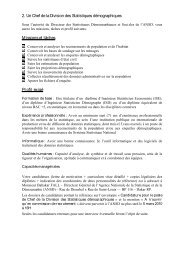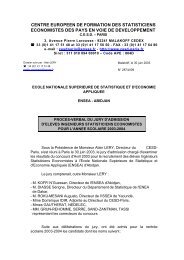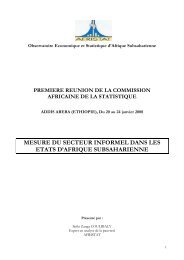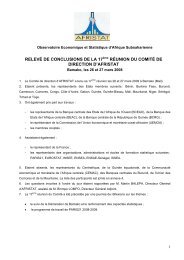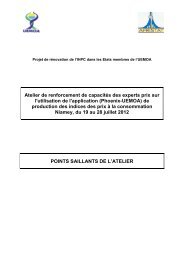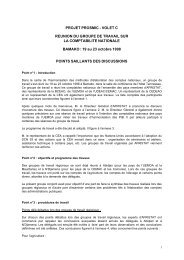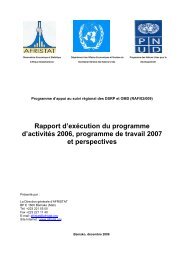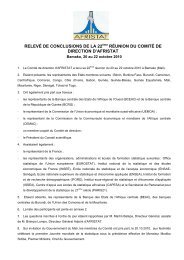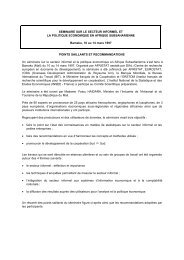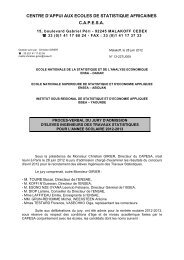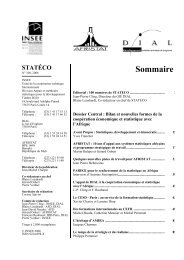Appendix AHistory of The ICPEconomic statisticians have long recognized that usingexchange rates to compare the levels of economic activitybetween economies can lead to quite misleading results.Several projects were initiated in the 1950s <strong>and</strong> 1960s toexamine the alternatives to exchange rates for making suchcomparisons. In the early 1950s, the Organisation for EuropeanEconomic Co-operation (OEEC) produced purchasingpower parities (PPPs) for France, the Federal Republicof Germany, Italy, the United Kingdom, <strong>and</strong> the UnitedStates. In the early 1960s, PPP comparisons were carriedout in Latin America. Around the mid-1960s, the Conferenceof European Statisticians set up a project to makePPP-based comparisons between some market economies<strong>and</strong> some centrally planned economies. Comparisons werealso made in the second half of the 1960s between severalEastern European economies by the Council for MutualEconomic Assistance (COMECON). Economic statisticiansfrom Hungary <strong>and</strong> Pol<strong>and</strong> were heavily involved inthis work. A key initiative was to extend the concept ofconsumption expenditure for the ICP to include individualconsumption expenditure by government along with privatefinal consumption expenditure to form an aggregate oftotal individual consumption called “consumption expenditureof the population (CEP).” The aim of measuringCEP was to minimize the effect on the volume comparisonsof differences in institutional arrangements, particularlyregarding the extent to which the government <strong>and</strong>private sectors provided health <strong>and</strong> education services indifferent economies. In this respect, the ICP was more thantwo decades ahead of the System of National Accounts, 1993(SNA93), which set out the concept of “actual final consumptionexpenditure” (defined almost identically to CEP)as an official national accounts measure.In 1965, the United Nations Statistical Commission(UNSC) discussed in some detail the problems inherentin exchange rate comparisons <strong>and</strong> agreed that the UnitedNations Statistical Office (UNSO) should develop a moresuitable methodology for making international comparisonsof activity levels. In 1968, the UNSC considereda report that outlined a project (to be run from 1968 to1971) aimed at developing PPP-based comparisons for asmall group of economies. It agreed that a project shouldgo ahead to develop, test, <strong>and</strong> document techniques thatwould lead to more robust international comparisons. TheUNSO had only limited resources available; therefore, theUNSC requested that other international organizations <strong>and</strong>UN member economies assist in this project. At this stage,the proposal endorsed by the UNSC was to cover GDPmeasured from both the expenditure <strong>and</strong> production (oroutput) sides of the national accounts. The work in PhaseI concentrated on the expenditure side of the accountsbecause it was less difficult to implement in practice, given167
168 <strong>Global</strong> <strong>Purchasing</strong> <strong>Power</strong> <strong>Parities</strong> <strong>and</strong> <strong>Real</strong> <strong>Expenditures</strong>that a single set of expenditures was involved, rather thanboth outputs <strong>and</strong> inputs, which gave rise to the added complexityof double deflation.Later in 1968, the UN International Comparison Project(ICP) was developed as a joint undertaking betweenthe UNSO <strong>and</strong> the University of Pennsylvania, whichestablished a special unit funded by a grant from the FordFoundation. The World Bank became involved, providingfinancial assistance directly <strong>and</strong> also through a grant fromthe Sc<strong>and</strong>inavian economies, which was channeled throughthe World Bank. The United States Agency for InternationalDevelopment <strong>and</strong> the United States Social ScienceResearch Council assisted with monetary contributions.The United Kingdom offered in-kind statistical support forparticipating economies. The director of the UNSO wasresponsible for supervising the project. An advisory board,which had been set up to provide technical advice, considereddetailed proposals for the project at a meeting held inOctober 1969.Phase I of the ICP was run in two stages. The first was apilot project based on data collected for 1967 for six economies(Hungary, India, Japan, Kenya, the United Kingdom,<strong>and</strong> the United States). The second stage was benchmarkedto 1970. Another four economies (Colombia, France, theFederal Republic of Germany, <strong>and</strong> Italy), which had notbeen able to report the necessary data for 1967, wereincluded in this stage. The output consisted of a numberof different sets of estimates, including multilateral comparisonsbetween all 10 economies for GDP <strong>and</strong> a rangeof its components for 1970. The results of Phase I werereleased in A System of International Comparisons of GrossProduct <strong>and</strong> <strong>Purchasing</strong> <strong>Power</strong> (Kravis <strong>and</strong> others 1975).Details presented in this publication include the overallresults of the multilateral comparison for 1970, a variety ofbilateral comparisons for both 1967 <strong>and</strong> 1970, <strong>and</strong> the outcomesfrom various experiments on important issues (suchas rents, motor vehicle prices, <strong>and</strong> the consistency of somedifferent quantity comparisons).Phase II involved a further six economies, initially for abroader comparison for 1970, but with the main aim beingto update the PPPs <strong>and</strong> associated statistics to 1973. Thesix extra economies included in Phase II of the ICP wereBelgium, Iran, Korea, Malaysia, the Netherl<strong>and</strong>s, <strong>and</strong> thePhilippines. Detailed results for the 16 economies werepublished in 1978 in International Comparisons of <strong>Real</strong>Product <strong>and</strong> <strong>Purchasing</strong> <strong>Power</strong> (Kravis, Heston, <strong>and</strong> Summers1978).For Phase III, ICP product lists were modified in consultationwith a number of economies, including India <strong>and</strong>the COMECON group, to make the ICP product specificationsmore generally applicable (for example, by removingcharacteristics such as br<strong>and</strong> names that were specific tothe United States). The greater diversity of economies inPhase III meant that the range of products to be priced hadto be exp<strong>and</strong>ed further so that all participating economiescould price a sufficient number of products that were representativeof their expenditures. At this time, the projectleaders considered the pros <strong>and</strong> cons of continuing with asingle global comparison or moving to regional comparisonsthat would be linked to produce worldwide results.The trade-off involved was that regionalizing the projectshould lead to improved comparisons between economieswithin a region, but at the expense of the comparisonsbetween economies in different regions because of the difficultiesinherent in linking results between regions. In theevent, Phase III went ahead as a single global comparison,although some regional results were presented, having beencalculated for the relevant economies from the globallybased results. Details were released in 1982 in World Product<strong>and</strong> Income: International Comparisons of <strong>Real</strong> GrossProduct (Kravis, Heston, <strong>and</strong> Summers 1982).There was a large increase—from 30 to 60—in thenumber of economies participating in Phase IV of the ICP,benchmarked to 1980. Some major changes also occurredin this round. The University of Pennsylvania ended itsinvolvement in the benchmark comparisons <strong>and</strong> h<strong>and</strong>edover responsibility to the UNSO. Another significantchange was the regionalization of the ICP for the first time.The large number of economies involved from all aroundthe world was partly behind the regionalization. Anotherimportant factor was the decision by the OECD to set upa PPP program for its member economies in conjunctionwith the PPP program being run by Eurostat for economiesin what is now the European Union. Apart from theEurostat-OECD “region,” the other regions involved inPhase IV were Africa, Asia <strong>and</strong> the Pacific (Asia-Pacific),<strong>and</strong> Latin America. Regions were linked using a “core country”(sometimes called a “bridge country”) approach, in



